
Buyer Guide
How to make your offer for a home stand out from everyone else's
A nationwide shortage of listings has created intense competition among buyers — many of whom will be submitting offers to purchase the same small pool of properties in a given community. It's commonplace for homebuyers to see their offers rejected a dozen times because someone else has put forth a stronger purchase package. But amid such high competition, there are ways homebuyers can bring their offers to the front of the line — without having to waive critical contingencies, like the home i














